The Sanctuary
The Ghisallo Pass
The Sanctuary of the Madonna del Ghisallo stands on a hill of the same name in Magreglio, along the Vallassina road from Erba to Bellagio, thanks to popular devotion.The Vallassina, between the Como and Lecco branches of Lake Como, offers fascinating landscapes, groups of houses emerge from the green among the irregular mountains.
The chestnut forests and pastures were the main sources of livelihood, with the Lambro River rising from these mountains and joining the Po.
From Canzo, you could reach Magreglio, with the small church of the Madonna del Ghisallo offering a spectacular view of a branch of Lake Como, the Grigne mountains, Mount Legnone and the Engadine. Beyond the sources of the Lambro, there was the “Pietra Luna”, an erratic boulder, and from the top of San Primo you could see the whole of Lario.
The dialectal name “Magrej” could derive from “Macrilium”, indicating a place with poor fertility. In 1570, the Archbishop of Milan assigned support to the Parish, noting its mountainous and barren nature.

The origins
In Italy, for centuries, it has been common practice to place sacred signs on heights, paths and in picturesque places to protect the inhabitants and wayfarers. In this region, numerous shrines and chapels bear witness to a solid Christian faith, thanks also to the work of Saint Miro (Canzo, 1336-1381).Tradition has it that the sacred image in the Sanctuary of Ghisallo was found years ago in the woods, offering security in a territory that was then dangerous. A certain Count Ghisallo, threatened by bandits during a hunting trip, turned to the Madonna of the Icon that he had met shortly before, thus saving his life. From that moment on, the effigy was called and venerated as the Madonna del Ghisallo.
The first certain historical record of the Sanctuary dates back to July 1623, when the inhabitants of Magreglio obtained permission to celebrate Holy Mass in the Chapel dedicated to the Blessed Virgin Mary, which they had rebuilt. Later, in 1660, the priest G.B. Bonanome established a legacy for the Masses of the Sanctuary, and in 1681, a three-arched portico enriched the church.
From 1706 onwards, thanks to the possibility of regularly attending religious services and its enchanting location, the small Oratory became a point of reference and a place of pilgrimage increasingly frequented. Small transformations and refinements have given life to the house of Mary that we know today.
The affectionate face of Mary seems to scrutinize the souls of visitors, offering comfort. The Child, with his hand raised in blessing, promises to be an understanding brother in joys and sorrows.
This sanctuary is not a museum, but the home of a loving Mother. Looking into Mary’s eyes, you find the strength to continue your journey. In this place of prayer, Mary responds to the sincere supplications of the faithful, granting graces and healings. Here, everyone is welcomed and loved with tenderness.
In a sign of gratitude, the Madonna is crowned with a golden crown melted down from donations of jewelry offered by the inhabitants and visitors. This little church in the mountains has become a center of Marian devotion, a place of protection and comfort for anyone who seeks it. Pilgrims stop in front of the reassuring image of the Madonna, a return to the maternal home for an always nostalgic, enriching and unique encounter with their spiritual Mother.
Don Ermelindo
After several experiences as vice-rector and spiritual father, he moved to Pian Rancio during World War II together with the Martinitt of Milan. From 1944 to 1985, he served as parish priest and rector of the Sanctuary of Magreglio, transforming it into a place of reference for cyclists.
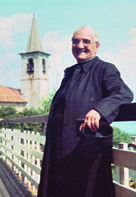
Don Ermelindo involves numerous champions such as Coppi, Bartali and Baldini, organizes races and obtains the passage of the Giro d’Italia and the Giro di Lombardia on the Ghisallo. Promotes the cyclist’s monument and many other initiatives to preserve the historical, moral and religious heritage of the area.
This fervent priest, in addition to promoting sport, celebrates the day of the sick in the Sanctuary every August, offering comfort and hope to both the sick and those who seek peace.
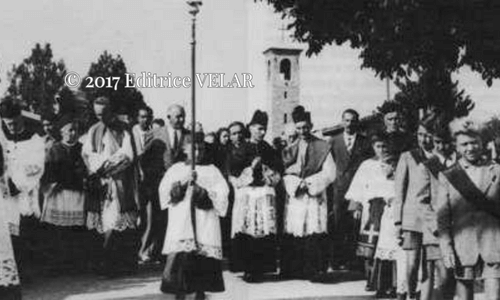
The Proclamation as Patroness of Italian Cycling
This event triggers a chain of events. In September 1947, Don Ermelindo wrote to Cardinal Schuster, asking for the proclamation of the Madonna del Ghisallo as Patroness of Italian Cycling.
The request is welcomed positively and supported by the Pope.
The program prevede che il 13 ottobre Pio XII accenda e consegni la fiaccola ai ciclisti, che partiranno dalla Basilica di San Pietro e raggiungeranno il Duomo di Firenze il 14 ottobre. On October 15, they will head from the Florence Cathedral to the Bologna Cathedral, on October 16 from the Bologna Cathedral to the Milan Cathedral, and on October 17 they will arrive at the Sanctuary of the Madonna del Ghisallo.
In June 1948, a delegation meets the Pope and obtains his official consent. The event is planned for October 13, 1948, including the arrival of the lamp offered by Italian cyclists to the Madonna as part of a cycling rally.
The program prevede che il 13 ottobre Pio XII accenda e consegni la fiaccola ai ciclisti, che partiranno dalla Basilica di San Pietro e raggiungeranno il Duomo di Firenze il 14 ottobre. On October 15, they will head from the Florence Cathedral to the Bologna Cathedral, on October 16 from the Bologna Cathedral to the Milan Cathedral, and on October 17 they will arrive at the Sanctuary of the Madonna del Ghisallo.
The blessing of the torch by Pius XII in Castel Gandolfo on October 13, 1948 is a significant moment. The votive lamp, created by the sculptor Carmelo Cappello, is 1.40 meters high and placed on a bronze stele. Around the lamp, four historical representations of Italian cycling are sculpted.
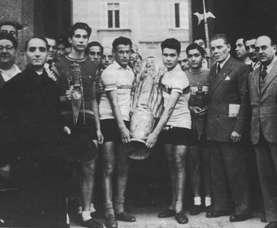
The relay
The parish magazine of Magreglio, “Fiaccola sul Colle”, narrates the event as a solemn day for the Sanctuary of Ghisallo, marking the beginning of a new story in which Italian cycling and the Sanctuary are intertwined. The Madonna seems to await her new protégés with a smile, and the church is decorated with stages, altars, speakers and flowers. The community mobilizes with religious functions, Masses and music.
At 10:30 a.m., the relay with the flame arrives, led by Gino Bartali and Fausto Coppi, followed by other cyclists. They carry the Lamp with joy and devotion, reading an act of consecration of cyclists to the Patroness. This symbolic gesture highlights the importance of the Madonna del Ghisallo as Patroness of Italian cyclists, welcomed with gratitude by the community.
In 1949, Pope Pius XII declared the Madonna del Ghisallo “Patroness of Cyclists” by means of a brief. The document recognizes the flame he lit the previous year, a symbol of Marian devotion in the hearts of cyclists. At the request of the Italian Cyclists’ Union, and in agreement with Cardinal Schuster of Milan, the Madonna del Ghisallo was elevated to principal Celestial Patroness of Italian Cyclists and, subsequently, of international cycling with the same title.
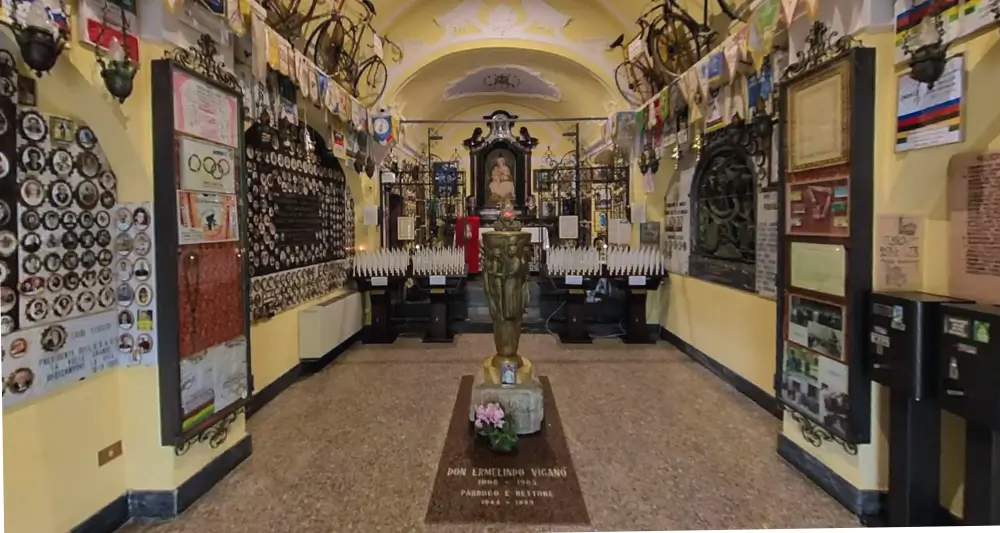
Devotion and affection
At first, many believed that only devout sportsmen like Gino Bartali honored the Madonna del Ghisallo as their protector. They were wrong, because the first to believe in the Madonna del Ghisallo as a protector were the champions themselves who prayed to her in the most dramatic moments of their careers. Their numerous votive offerings that adorn the Sanctuary are a confirmation of this. Don Ermelindo, a keen observer who sees them returning to the foot of the Madonna, is sure that that little seed of devotion will bear fruit. His belief is that the return itself is an act of faith and devotion: “The young come to pray because they are inspired by the champions, the elderly turn to the Madonna because they want to continue to pedal for as long as possible.”
Inside the Sanctuary, a small space houses an incalculable number of ex-votos. Champions such as Coppi, Bartali and Magni donated their victorious bicycles to the Madonna, and others, such as Eddy Merckx, Gianni Motta, Felice Gimondi, Francesco Moser, Maurizio Fondriest and Fausto Casartelli, followed their example. The bicycle of the Bersaglieri of the First World War, that of Alfonsina Strada, the first woman to compete in the Giro d’Italia in 1924, and that of Evelina Bianchetti, who died in a road accident, are also testimonies of faith.” Initially, these bicycles were on the ground, but when the saddle of Magni’s bike disappeared, Don Ermelindo decided to hang them on the walls already covered with votive offerings.
The jerseys of champions such as Binda, Bartali, Coppi, Gimondi, Moser and many others were also on display as a sign of devotion. Jacques Goddet, known as the “Patron” of the Tour de France, had donated a yellow jersey in his name. The news of the Madonna del Ghisallo as the Patron Saint of Italian cyclists has attracted cyclists and sportsmen from all over Europe, as evidenced by the plaques and testimonials on the walls of the Sanctuary.
The lamps of the regional committees, the flags, the photographs, the posters and other forms of devotion invite visitors to offer a thought and a prayer to the Madonna. On the left wall, two plaques commemorate the cyclists who died during the races, highlighting the sacrifice of their young lives. Don Ermelindo observes with consolation that many cyclists of different categories, young and old, Italian and foreign, visit the Sanctuary not only to make a pilgrimage to their Patron Saint, but also to find comfort and inspiration in the wonderful panorama of the Lombard Prealps, facing the Grigne mountains and the lakes. In this place, they seek not only physical rest for tired limbs but also the moral strength to face life’s challenges and disappointments.
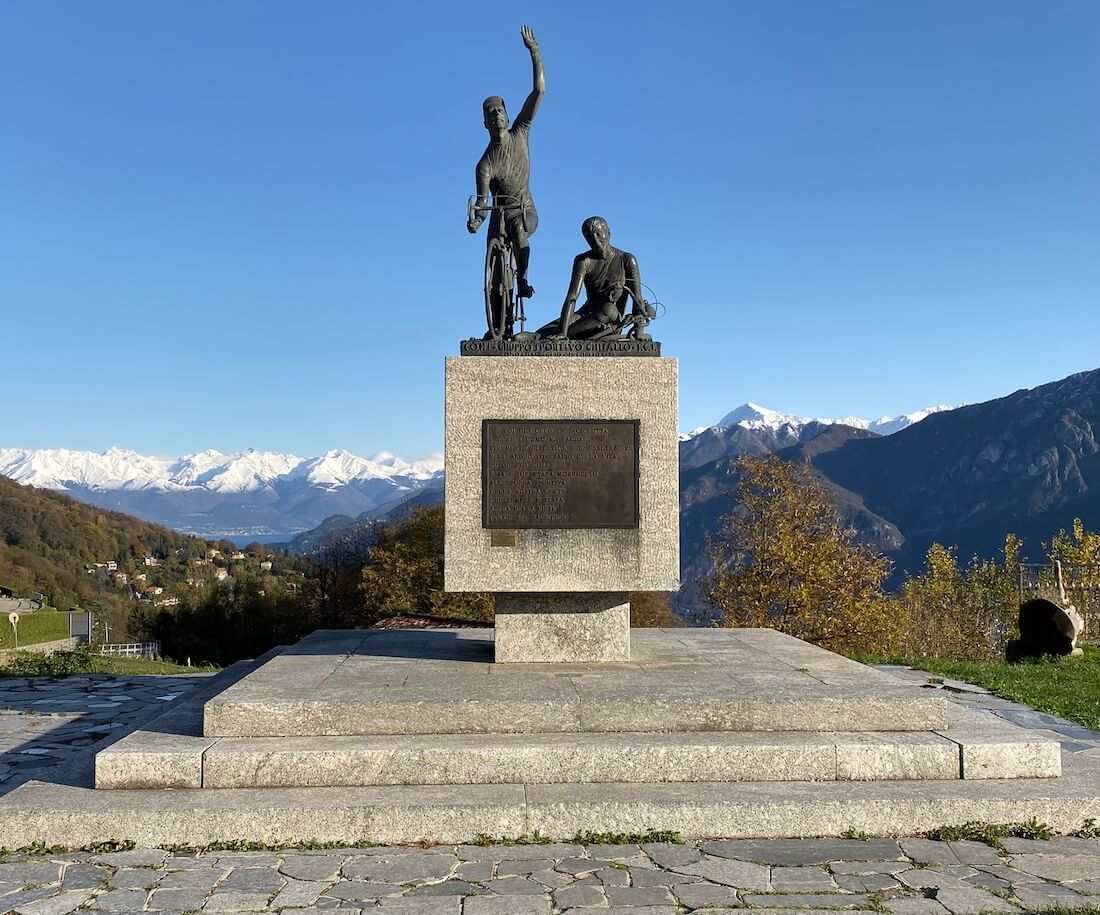
The Square
The square in front of the Sanctuary offers a panoramic view of Lake Como and the surrounding mountains, with the Grigne mountains in the foreground and the snow-capped peaks of the Engadine in the distance. In 1973, a monument dedicated to cyclists was erected next to the Sanctuary. Made of bronze, it weighs 4 quintals and was blessed on July 15, 1973. It represents the struggle between victory and defeat, with the gesture of a winner crossing the finish line raising his arm and another exhausted runner. A quote by Bruno Raschi states that the bicycle is a tool for practice and exaltation in life.
In front of the church, there are marble columns that remember important figures linked to the Sanctuary, such as Emilio Colombo, Fausto Coppi, Don Ermelindo, Gino Bartali and Alfredo Binda. In 2011, a stele was added in memory of Alfredo Binda, known for his faith and contribution to cycling. In 2015, a stele was erected in honor of Don Luigi Farina, rector of the Sanctuary for twenty years and confessor of cyclists. Near the cyclists’ monument, there is a memorial stone dedicated to Vincenzo Torriani.
In 1979, a historic event was celebrated: the twinning of the Shrines of the Madonna del Ghisallo and the Black Madonna of Częstochowa. This event was marked by a religious ceremony held on September 22 at the Polish church and by a private audience with Pope John Paul II on September 26. During this last occasion, two parchments containing the seal and signature of Pope Wojtyla were delivered to officialize the twinning. A copy in Polish was sent to the rector of Czestochowa, Father Joseph Frank, while the other, written in Italian, remained in the hands of the rector of the Madonna del Ghisallo, Don Ermelindo Viganò. The latter was presented to the public during the closing ceremony held the following morning.
Even though many years have passed since this historical event, the constant flow of pilgrims and tourists demonstrates how this experience of faith is still alive and significant. It is hoped that this uniqueness will continue to inspire and touch the hearts of those who visit this special place in the future. The Sanctuary offers an oasis of serenity and peace, with a breathtaking natural backdrop that ranges from the blue and green of the sky and lake to enchanting winter landscapes. Inside the Sanctuary, young and old alike are captivated and moved by its beauty and spirituality.

Official website of the Sanctuary of the Madonna del Ghisallo: the sanctuary of cyclists.
Virtual tour of the Sanctuary.
